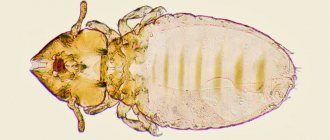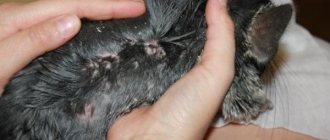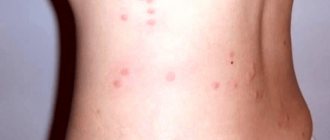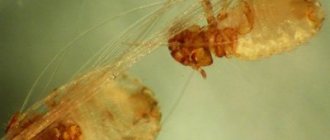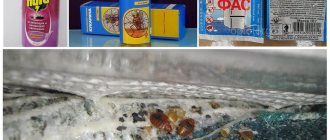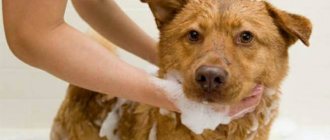Adviсe
- Treat all your pets with flea treatment, even if you think they don't have fleas. This will help you get rid of fleas faster and reduce the likelihood of them appearing again.
- Clean the interior of your car, pet crates, and other areas where the rat may have been.
- If you still don't know how to bathe and brush your rat, you'll have to learn how to do it. Train your rat to come to your hands (this may take some time). If you have an untrained rat, grab it under its belly when you pick it up. Never squeeze a rat or pick it up by the tail or paws. Always handle the rat with both hands. Also, remember that a sleepy or tired rat is easier to deal with.[6]
Ways of infection of rats with ectoparasites
Most often, rodents become infected with ectoparasites through direct contact with other animals - mice, dogs and cats. But there are other ways of transmitting parasitic diseases:
- Through infected inventory.
- Through the filler. Lice eaters and ticks can live in wood filler, which the owner buys not from a pet store, but from a sawmill. Such material does not undergo processing, which means it may be contaminated.
- Often the person himself brings lice eaters and other ectoparasites into the house on his clothes or shoes. After some time, they find their prey (pet) and begin to reproduce.
How to treat an infected rat
It is advisable that the treatment of an infected rodent be carried out by specialists from a veterinary clinic. A doctor who deals with the recognition and treatment of rodent diseases is called a ratologist. He will clarify the type of parasite, prescribe the most effective tactics and recommend a drug that will help a specific breed of domestic rat. But if for some reason you do not have the opportunity to contact a specialist, you can treat your pet yourself.
Find out why your pet rat itches.
What can be processed
If signs of the presence of parasites are detected, you need to get rid of them using the following effective medications:
- “Unoiled.” Dilute 2 ampoules with water, then thoroughly treat the entire surface of your pet’s body. Pay special attention to damaged areas of the skin. Keep the rat wrapped in a towel until the solution dries. This is necessary in order to prevent the animal from licking the drug. After 10 days, repeat the procedure.
- "Frontline" (spray). Spray the product twice on your pet's body. Hold the rat in your arms until the preparation dries. After 7–10 days, repeat the procedure.
- "Bars" (insectoacaricidal spray for cats and dogs). The solution must be sprayed onto the withers and also wiped over the affected areas of the skin. Repeat these procedures after two weeks.
A separate group of drugs has been developed to combat subcutaneous and ear mites:
- "Stronghold" (drops, bottle comes with a purple cap). Dosage at the withers - 0.01 ml per 100 g of animal weight.
- “Lawyer” (drops on the withers).
- “Dironet Spot-on” (drops on the withers).
- "Prasicide-complex" (drops). One application is enough to save the animal from subcutaneous ticks.
If parasites are detected on one pet, all animals living in the house will need treatment. In addition, it is important to carry out general cleaning and disinfection in all rooms. The cage, feeder, water bowl and all toys must also be disinfected. And the bedding and filler need to be changed. All wooden objects in the cage (sticks, toys) should be removed from the house.
Gamas mite in the apartment
Predatory gamasid mites, which attack people and pets, most often end up in apartments for one of the following reasons:
- Parasites entered you on their own from the street through windows, cracks in window frames, and ventilation.
- We arrived with pet hair, shoes, clothes, and shopping.
- They crawled from the basement, attic or cavities in the structure of a building or house where birds nest, rodents, amphibians and other insects live.
In order for a gamas tick to feel comfortable in an apartment, it needs:
- Food sources - people or animals
- Darkness
- Air humidity above 50–60%
- Increased warmth
Gamasid mites do not live permanently on those they bite. In nature, attacking birds, animals, amphibians, reptiles and insects, they usually settle near or inside their burrows, nests or other shelters. In a person’s home, the insect will find a place similar to what it chooses in nature. It can be:
- Products made from down and feathers
- Products made from natural fabrics
- Houseplants
- Small and large household appliances
- Cracks, space behind peeled wallpaper
- Area under the window sill
- Interior items, especially from natural materials
Parasites are attracted to heat, movement and carbon dioxide. It is these criteria that they will be guided by both when choosing shelter and when choosing a food source. To avoid wasting time looking for food, ticks are likely to choose a place for nesting near a bed, sofa, armchair or chair where a person spends a lot of time. If there are pets in the house, this could be a bed, a scratching post, toys made of fleecy materials, bedding in a cage or a terrarium.
Appearance
These insects are divided into varieties; the most common type of flea is the southern rat flea.
With the naked eye it is impossible to distinguish them from other relatives - dogs, cats and domestic ones. Only a specialist can determine the species under a microscope.
The rat flea looks similar to other representatives of the genus: the body has an elongated shape, flattened on the sides, the back part is raised due to long jumping limbs.
It is covered with chitinous cover and has a dark brown color. Length – from 3 to 5 mm.
Consequences for animals
The animal becomes lethargic, exhaustion appears, and immunity decreases. As a result, chronic problems worsen, infectious diseases and colds become more common.
Anemia and vitamin deficiency may develop. Another danger of lice eaters is that they themselves are carriers of many diseases and can cause fungal, viral, bacterial, and helminth diseases.
In any case, infestation with parasites undermines the health of the infected animal, causing numerous problems.
If lice eaters are found in budgies, then in the absence of treatment and prevention measures, the birds may die! Very often, lemon tree owners may notice strange growths on the plant - these are scale insects. Find out how to get rid of it by reading our article.
Rat flea bites are very dangerous, as these parasites carry many diseases. What to do if you find bites of these insects, read the link https://stopvreditel.ru/parazity/perenoschiki/krysinaja-bloha.html.
Composition and effect of the drug
The product is available in the form of a concentrated emulsion. Before use, prepare a solution in the dosage specified in the instructions. The concentrate must be diluted immediately before use, or at least within 2 hours after preparing the solution. Under other circumstances of use, the drug loses its effectiveness.
The active components are new generation synthetic insecticides:
Remedies for rat tick bites
Before using any remedy for tick bites, you must directly remove the tick itself. To do this you need to do the following:
- steam the affected area, soften the skin with cream;
- disinfect the skin by treating it, for example, with alcohol, Chlorhexidine, Septocide;
- remove the tick using a special twister;
- consult a doctor.
After removal of the parasite, antihistamines are prescribed (for example, Cetrin, Loratadine). Medications with antiparasitic and antiseptic effects are also used.
Benzyl benzoate ointment 10%
It is an antiparasitic drug used topically. Available as an ointment in metal tubes or glass jars.
The duration of treatment is about 4 days.
The first treatment with ointment is done in the evening before going to bed. The skin of the arms, torso, legs, including the soles and fingers are treated. Treatment is carried out on clean skin. After treatment, you should put on clean underwear and clothes. In the next 2 days, it is necessary to take a break from therapy, and it is forbidden to wash off any remaining medication from the skin. On the 4th day in the evening, repeated treatment is carried out, similar to that on the first day. On the 5th day the ointment is washed off.
Sulfuric ointment
It is an anti-itch agent and is used externally. The product is released in the form of an ointment in metal tubes.
The duration of treatment is from 7 to 10 days.
The drug is applied in a thin layer to the affected areas of the skin 2-3 times a day for the specified duration of treatment. After completion of therapy, taking a bath is allowed; changing underwear and bed linen is necessary.
Wilkinson's ointment
It is a product for external use, which contains tar, sulfur, and naftalan oil. Has anti-inflammatory, antiseptic, antiparasitic effects. The product is produced in the form of an ointment in tubes and glass jars.
Used externally. Once a day, the ointment is rubbed into the skin of the entire body, excluding the face and scalp. Duration of treatment – 3 days.
What do bites look like, treatment
The problem of rat fleas is relevant for residents in private sectors; they are extremely rare in the city. But after a bite, serious complications can develop.
The affected person begins to turn red, and multiple red dots may form. This indicates the development of an allergic reaction. The bite area itches very much, so it cannot be ignored. After a certain period of time, a blister appears, but it disappears very quickly, and a wound forms in its place.
Parasites affect the lower part of the legs: legs, feet. But other parts of the body may also be affected: neck, armpits, arms. This means that they have moved onto the bed, furniture, and clothes. You will have to do some general cleaning, a vacuum cleaner helps a lot, just don’t forget to disinfect it after use.
Treatment
After a flea bite is discovered, immediate action must be taken, especially if a child has been bitten. To avoid possible complications, you must adhere to the recommendations below:
- Treat the affected area with any antiseptic composition. You should also use a soap or vinegar solution. They are prepared with water in equal proportions. If the skin is severely damaged, treat the wound several times a day.
- To relieve itching, apply an ice cube or any other cold compress. Also, these measures will help relieve inflammation, reduce swelling, and the skin will take on a normal appearance.
- Apply antiseptic ointment or cream, which is available in your home medicine cabinet. For example, it could be sulfur ointment, calamine lotion, Boro-plus. But a regular soda solution will also work. Furacilin and hydrocortisone are suitable as steroid ointments. They will relieve pain and itching. But before using them, get qualified advice.
- If an allergic reaction occurs in the form of a rash, take an antiallergic drug. In this case, it is better to coordinate treatment with an allergist.
- Lotions made from the juice of marigolds, plantain, burdock, dandelion, and parsley will help relieve itching, swelling, and moderate the inflammatory process.
Urgent medical attention is needed if a pustular mass, urticaria, fever, or headache appears.
Prevention of parasites
- Cleaning
If you suspect all rats have parasites, you should completely empty their cage, clean and disinfect all contents, as well as the cage itself. Throw away anything wooden or cardboard inside the cage. If there is carpet in the room, it is worth having it professionally cleaned if possible. Professional carpet cleaners are usually relatively inexpensive and can clean carpets in a very short time.
In any case, it is recommended to clean and disinfect the cage and its contents at least once a week.
- Caring for Rat Paw Nails
Keep your rat's toenails trimmed to prevent scratches and wounds they may inflict on themselves. Damaged skin caused by scratches allows bacteria to enter. Once the scabs form, the rats begin to itch. This leads to a vicious cycle of more scratches, skin damage, bacteria and scabs. Some rats need their toenails trimmed once or twice a week.
Lifestyle
Bloodsuckers cannot remain on the victim’s body all the time. After eating, the flea jumps off and returns to its permanent habitat. They often settle in rat nests and lay eggs here. People know that pets have blood-sucking parasites, but do rats have fleas? They are present in all living organisms, even in humans, but are called a little differently. Females can produce up to 400 of their own kind. They lay 7 eggs per day. The development of the larva takes up to 16 days, then is wrapped in a cocoon.
An adult flea emerges from the pupa. Can go without food for a long time. But then, when it chooses a suitable victim, it will suck blood for a long time.
Description and photo of rat and mouse mites
Everyone knows about ixodid ticks. Instructions on what to do if you are bitten by an ixodid tick can be found at any medical facility. Few people have heard of Gamasidae. Even fewer people have thought about how dangerous these ticks are to humans. They are so small. Gamasid bloodsuckers usually do not tolerate tick-borne encephalitis, but they can also cause a lot of trouble. The rat mite is especially dangerous. It was he who previously carried typhus from rats to humans. Today his main “specialization” is tick-borne dermatitis.
Ways to combat parasites
The most effective way to rid your home of fleas is to call a professional. They will carry out comprehensive treatment of the premises using professional means. Exterminators can be ordered from the sanitary and epidemiological station or a private insect control company.
To prevent re-infection, it is necessary to poison the parasites from your neighbors, since getting rid of rat fleas in one apartment is not enough. They easily move around the entrance and penetrate through doorways and cracks.
It is also necessary to carry out preventive measures in basements and attics.
An important stage in the fight against insects is the treatment of all domestic animals, replacing their bedding with new ones.
Drugs
Aerosols are a popular remedy - they can be used to remove rat fleas from an apartment, as well as treat animal fur with special compounds.
Medicines for pets are purchased at a pet store, and for general treatment of the premises, sprays from hardware stores and supermarkets are suitable: Raid, Kombat, Raptor, Medilis Cyper, Karbofos.
Insect killing dusts are effective against flea larvae.
Modern microcapsule products GET successfully get rid of parasites. Their main active ingredient is chlorpyrifos. This is a toxic substance that quickly kills rat fleas, but precautions must be taken when handling.
It belongs to the third hazard class, so its use is permissible only with protective equipment, without people or animals nearby. After treatment, a thorough wet cleaning is carried out.
The drug is often counterfeited. One of the manufacturers chose a similar name Gett - this product is several times cheaper, but is less effective.
Drops
Since removing fleas from just one room is not enough to completely destroy them, pet fur is treated.
The drops are low toxic, do not harm the pet, but are effective against parasites.
They should be applied to the skin where the animal cannot lick it off. Any drugs that are offered in pet stores are suitable - “Clandestine”, “Bars”, “Stronghold”.
For additional therapy and prevention of new infestations, anti-flea shampoos are used - “Mr. Kiss”, “Frontline”, “Clandestine”.
The product is sprayed onto a piece of gauze and then rubbed into the animal's skin.
Folk remedies
When there were no special insecticides, people protected their homes from fleas using natural means.
It was believed that insects did not tolerate strong odors, so the main means of control were garlic and wormwood.
The following herbs are also used:
- chamomile;
- tansy;
- Bay leaf;
- mint.
They are hung in bunches around the house or an infusion is brewed and sprinkled. The garlic is crushed and placed in all corners where fleas may hide. After half an hour, wet cleaning is carried out. Vinegar is added to the water to enhance the effect.
Folk remedies do not guarantee complete destruction of parasites, but can be used as part of a set of pest control measures.
Infection of residential premises
Unfortunately, situations are possible when rat and mouse parasites infect apartments. This is a truly serious problem that requires the help of specialists. The first thing you need to do is make sure that the room is infested with rat mites. This can be done by a disinfectant. In the event that infection is confirmed, disinsection is carried out.
When carrying out disinfestation, potent drugs are used that are aimed at getting rid of parasites. In this case, it is necessary to treat all possible locations of insects. In cases where pets live in the house, be sure to visit a veterinarian who will recommend a remedy for treatment.
It is very important in this situation to find the cause of the infection; if this happened due to the presence of mice and rats in the basement, then this room must also be treated, since the situation will repeat itself.
Reproduction
In order to lay eggs, the female rat flea must be well fed . Females lay larvae in nests, animal cages, and also directly into their fur. After the eggs are laid under favorable conditions, after some time the larvae hatch from them. The larvae of rat fleas live in the nests and cages of their hosts, this provides them with constant nutrition. The larvae feed on the remains of animal hair, grass, and the excrement of adults. The fact is that the excrement of adult fleas contains blood, which the larvae like.
After some time, the larvae pupate. The insect will not come out of the cocoon until the environment is favorable. Scientists have proven that in a cocoon state, these pests are able to remain viable for about one and a half years.
After the onset of favorable conditions, an adult rat flea emerges from the cocoon and is ready to give birth to its offspring.
Depending on their habitat conditions, these insects can live up to several months . Over the course of her entire life, a female can lay up to 500 eggs.
Treatment of an infected rat
Specifying the type of parasite and prescribing treatment should be carried out by a specialist in a veterinary clinic, since different medications are used to destroy external and subcutaneous parasites. In case of complications, the animal is prescribed anti-inflammatory ointments, immunostimulating drugs and a course of vitamins and antibiotics.
Insecticidal preparations are highly toxic; if handled incorrectly or in excess of the dosage, there is a risk of poisoning a decorative rat. It is advisable that the animal be treated by a veterinarian; it is also permissible to treat a furry pet at home in a well-ventilated area, strictly following the recommendations of a specialist.
At the same time as treating your pet, you need to throw away the bedding, disinfect the cage and all accessories several times, change the filler, and treat the entire room with repellents. It is advisable to throw away all wooden objects from the cage; they can be places where parasites accumulate. The rodent's claws should be trimmed short during treatment to prevent scratching of the skin.
When keeping domestic rats in groups, all rats must be treated repeatedly to avoid re-infection. If a pet is bitten by fleas or bedbugs, it is recommended to treat all pets living in the house with insecticides, as well as the room itself: carpets, upholstered furniture, mattresses, floors, etc.
Symptoms of infection
Flea bites cannot be ignored - when the proboscis is inserted under the skin, they do not inject any anesthetic enzymes, like other blood-sucking insects.
In addition, the wounds are very visible externally - the parasites cause irritation on the skin, which is accompanied by itching, swelling, and redness. Most often, it is bites on a person that reveal their presence in the house.
If a rat has fleas, scratching marks, bald spots and scabs will be noticeable on its body. The pet will jump sharply from time to time, reacting in a similar way to painful bites.
Other pets exhibit the same symptoms as when infected with other types of fleas - nervousness, constant scratching of the skin, especially in hard-to-reach places.
What symptoms do the bitten areas show?
Ticks love to bite most of all where a person's skin is thinnest and most delicate. If anyone is wondering where to look for such a tick on the body. Where he likes to go most of all, we can say with confidence that these bloodsuckers really like to suckle in places such as:
- under clothes that fit tightly to the body - under the belt, for example, where the collar, cuffs are, under the straps on the wrist, and so on;
- in the depressions on the body - armpits, navel, ears, etc.;
- inside folds of skin - in the groin, on the abdomen, under the mammary glands.
The symptoms of a tick attack and the appearance of the bitten areas can be represented by the following manifestations:
- There is a feeling as if someone is crawling over the body or moving in one place.
- The affected area is constantly itching.
- Redness of the skin at the site of the bite.
- A black or brown dot if the insect has attached itself to the skin.
- A red dot on the skin if the insect fell off on its own after drinking blood.
- A rash if enough time has passed after the bite for an infection reaction to occur through the blood.
- An increase in temperature already indicates infection of the body.
General symptoms persist for about two weeks, and the bite mark can still last 20 days. After this, the disease caused by the infection enters into an active phase if you do not rush to treat the bitten area in time.
Parasitic diseases of rats
In decorative rats, parasitic diseases caused by fleas, lice, and lice are most often diagnosed. The reason for this is the lack of regular treatment of cells and household items, and unbalanced nutrition.
Fleas on rats
The causative agent of flea infestation in decorative rats is ectoparasites from the order Siphonaptera. This disease is diagnosed as aphanipterosis. It is accompanied by dermatitis, since flea saliva contains toxic substances that cause allergies in the rodent.
The danger of flea infestation is that one flea can drink up to 11–16 μl of blood per day. And with mass reproduction, this can cause anemia in a decorative rat.
Aphanipterosis is accompanied by itching, which leads to scratching on the skin. When bacteria and infections get into open wounds, they begin to fester. This leads to a chronic relapsing course of the disease.
Lice and lice in rats
Infection of a decorative rat with lice and lice-eaters is diagnosed as pediculosis. The incubation period of the disease can last about a month.
Main symptoms of the disease:
- constant itching;
- red dots, scratches in the muzzle, neck, shoulders;
- anemia, causing weakness, drowsiness;
- refusal to eat;
- sudden weight loss.
The danger of pediculosis is that its pathogens are also carriers of diseases such as typhus and hemobartonellosis.
Weight loss
Preventive measures
Prevention of infection of a domestic rat with ectoparasites includes the following measures:
- use of high-quality litter fillers;
- limiting the contact of the rodent with other pets;
- sending new animals to quarantine for a period of at least 2 weeks;
- regular cleaning and disinfection of cages and equipment;
- washing shoes after being outside;
- strengthening the immunity of the domestic rat.
Ectoparasites are very dangerous, so it is important to detect signs of infection in time. Every pet rat owner should regularly examine their pet for scratches and wounds on the skin. If they exist, it is worth showing the animal to a veterinarian and, if necessary, starting treatment.

